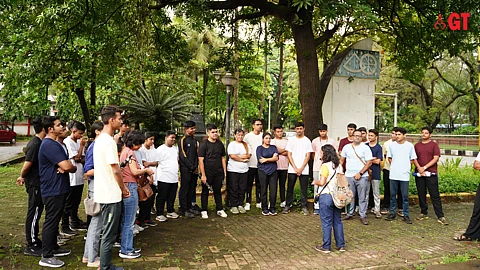

BY PRAVEENA SHARMA
You would be amazed at how much history resides within a few square kilometres of central Panjim, to be precise the Campal area.
Mugdha Pawar, the erudite storyteller of the heritage tour firm Make It Happen, opened our eyes to it as we passed by historical landmarks during the Campal Heritage Walk. As she did this, events of the past revealed themselves and lent a better understanding of today’s Goa.
The state government’s move to take Goa tourism beyond beaches has seen heritage walks, eco-adventures and other such experience tourism gaining popularity.
So, it was not surprising that the tiny coastal state, as a part of its celebration to mark World Tourism Day on Wednesday (September 27), decided to take students of the Institute of Hotel Management, V M Salgaocar Institute of International Hospitality Education and Don Bosco College on a heritage walk.
It was organised by the Travel and Tourism Association of Goa (TTAG), SKAL-Goa and Goa Tourism.
The heritage tour kicked off from Kala Academy, once a thriving hub of Goa’s art and culture, at 8 am and meandered through the lanes and bylanes of Panjim.
In two hours, Pawar made several pitstops at historical monuments and buildings to explain their significance in Goa’s past of over 450 years.
She did this by engaging the students, most of whom were from outside the state; prodding and nudging them to be more participative and emotive. Mostly succeeding in arousing their interest in her narrative on Goa’s history.
The layout of this part of Panjim, which was built under the supervision of Viceroy Dom Manuel in 1843 when the Portuguese decided to shift their capital from old Goa to Panjim, is based on the blueprint of Lisbon – the capital of Portugal.
It was transformed from a marshy land to a neatly laid out city with amenities that exist even today. To connect villages around the area, Manuel constructed six bridges. These bridges have withstood the ravages of times and have traffic plying over them even today.
Driven by his zeal and ambition, Manuel adopted harsh and unfair methods to complete his work and ended up in jail.
It was only many years later, in the 1900s, when people realised how the city’s efficient design facilitated its smooth functioning that he was posthumously given the title of Father of Nova Goa.
Manuel’s Panjim attracted many nobles who settled in the area.
To beat the heat and humid climate of Goa, they planted trees and built gardens. Campal Garden became a bustling place of recreation and entertainment. It drew performers from all parts of the state to entertain the well-heeled of those times in the bandstands that stand to this day.
In the auction of the 1920s, five plots were bought by the prominent Goan family of Jack de Sequeira, who is known as the Father of the Opinion Poll for his drive to get independent status for Goa after liberation.
The Sequeiras were also established businessmen, who quenched Goa’s thirst for soda with their local brand Top Cola (when Coca-Cola and Pepsi were not allowed in India). Their office building still stands in its past glory.
Not very far from it is Maquinez Palace, built by two brothers – Cristovam de Costa de Ataide and Diago de Costa de Ataide – in 1702 to escape the crowd of Old Goa. Their tranquillity did not last long.
The outbreak of a plague saw people from Old Goa resettling near the palace, compelling the brothers to return to Portugal.
In 1842, Asia’s first Western medicine college – Escola Medico Circurgica de Goa (now Goa Medical College) – was housed in the building. At one end of this structure is a chapel – Our Lady of Victory (formerly known as Our Lady of Sorrow) – built in 1720.
To this day, medical students graduating from GMC receive their first stethoscope at this chapel. In 1927, GMC was moved to a new building nearby and the palace is now being used by the Entertainment Society of Goa (ESG).
So much history and more is packed in less than 20 sqm and stares at you every time you cross one of the six bridges.
Take a quiet stroll in Campal Garden, watch a classic French movie hosted by ESG or just drive to Fisherman’s Wharf for a lively musical evening and savour Goa’s lingering legacy of the past.